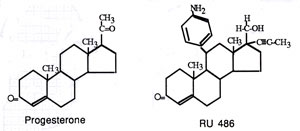![]()
![]()
![]() |What is RU-486? | The Discovery | The Chemistry |
|What is RU-486? | The Discovery | The Chemistry |
|The Global Use | RU-486 in US Politics |
| Cultural Controversy in the US | References |
RU-486 was truly a collaborative effort between a number of scientists and various pharmaceutical companies over an extended period of time. Below is a timeline outlining the progress and development of RU-486.
1932 – German scientists determine the chemical structure of steriods including estradiol, testosterone and progesterone which became the template for creating drugs which imitate the structure of sex hormones.
testosterone progesterone
1940s – Professor Russell E. Marker discovers that process by which sex hormones are synthesized leading to their mass production specifically to be used in drugs.
1962 – Dr. Gregory Pincus determines through a set of experiments with rats and mice that antiprogestins could “act on specific receptors, located mainly in the nuclei of cells in the uterus and stopping the growth of the egg” (Lader, 1991, p. 29). By this time, it was widely known that progesterone played a central role throughout a woman’s pregnancy as it assisted in preparing for implantation.
mice that antiprogestins could “act on specific receptors, located mainly in the nuclei of cells in the uterus and stopping the growth of the egg” (Lader, 1991, p. 29). By this time, it was widely known that progesterone played a central role throughout a woman’s pregnancy as it assisted in preparing for implantation.
1970 – Etienne-Emile Baulieu embarked on research regarding the progesterone receptors in Paris, France in the hopes of learning more about th e “lock and key” model that described the relationship between receptors (as locks) and sex hormones as well as steroids (as keys).
e “lock and key” model that described the relationship between receptors (as locks) and sex hormones as well as steroids (as keys).
1970s – Roussel Uclaf Company, led by Dr. George Teutsch, attempts to find an anti-cortisone compound and use progesterone throughout their research as it is quite similar to cortisone in its chemical structure (see below). Teutsch hoped to find “a molecule that would bind to and block the receptors without triggering the normal hormonal response” (Lader, 1991, p. 33).
1975 – Through the separate efforts of Teutsch and Baulieu, it was found that “the relationship between receptor concentration and hormone action […] might prevent progesterone-induced changes and consequently implantation” (Lader, 1991, p. 34). After testing over 900 compounds, anti-progesterone was found while looking for an anti-cortisone through a shotgun approach (Lader, 1991, p. 35).
relationship between receptor concentration and hormone action […] might prevent progesterone-induced changes and consequently implantation” (Lader, 1991, p. 34). After testing over 900 compounds, anti-progesterone was found while looking for an anti-cortisone through a shotgun approach (Lader, 1991, p. 35).
1980 – RU-486 was first synthesized by researchers at Roussel Uclaf.
1982– First successful human testing of RU-486 was completed.



